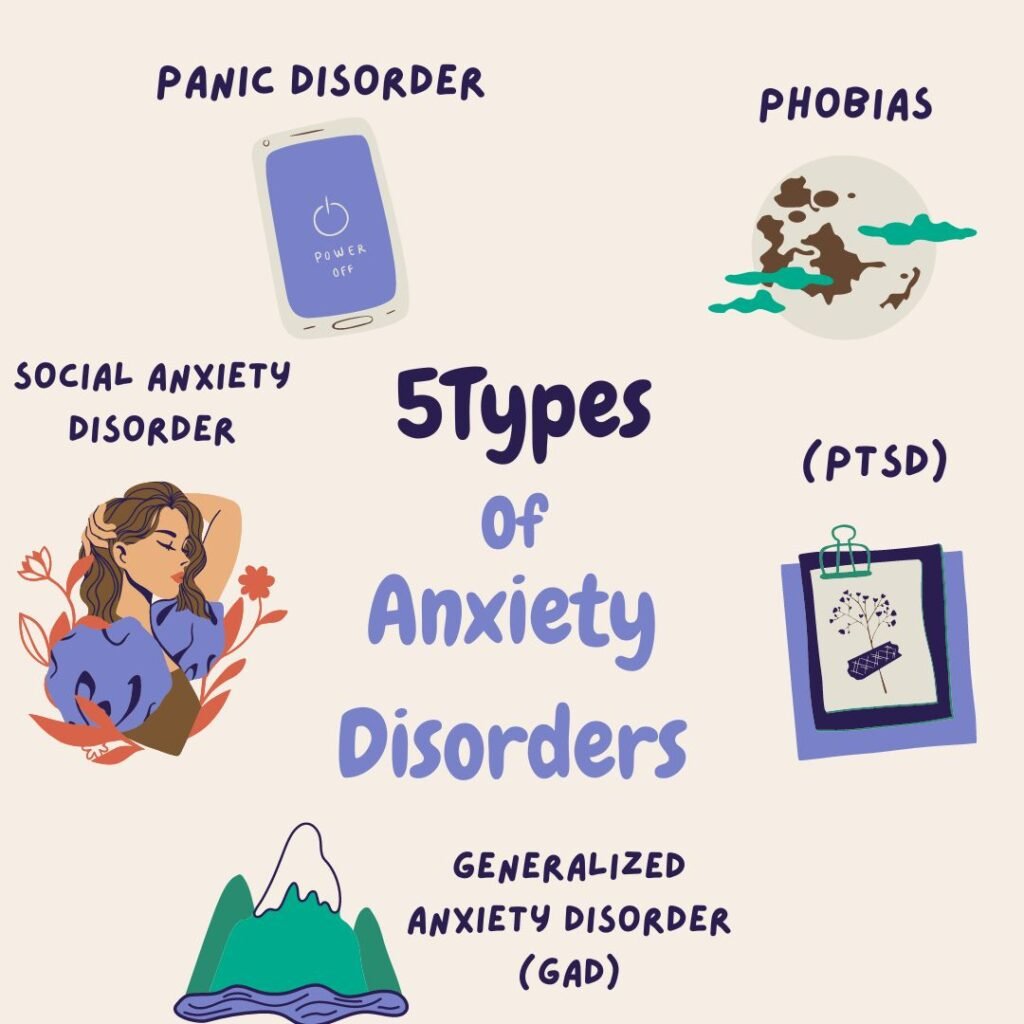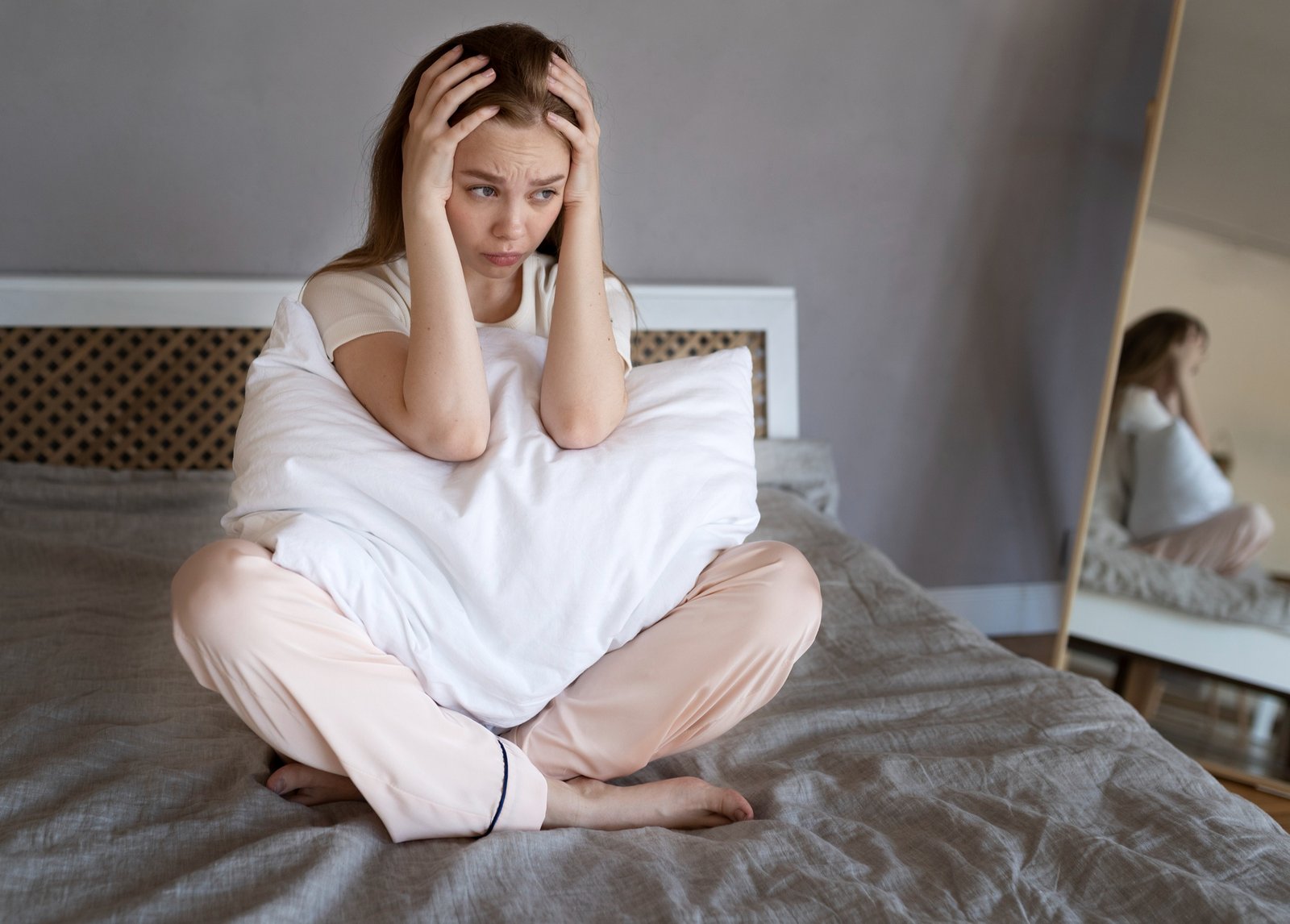What does anxiety entail?
Anxiety is a universal phenomenon, touching every individual at some point in their journey. It represents a typical human response characterized by a sense of discomfort or apprehension when confronted with situations deemed intimidating or alarming.
While anxiety may be unsettling, it serves a crucial purpose by heightening our awareness and priming our bodies for the instinctual “fight or flight” response—either confronting the perceived threat or seeking refuge from it. Typically, as we distance ourselves from the triggering circumstances or grow accustomed to them, the intensity of anxiety diminishes. However, persistent or severe anxiety has the potential to disrupt daily life.
Physical Manifestations
Physical symptoms of anxiety manifest in a myriad of ways, each signaling the body’s response to heightened stress and apprehension. From the rapid palpitations of the heart to the shallow breaths that struggle to fill the lungs, tension can cloak itself in a cloak of bodily discomfort. Tense muscles may ache with the weight of unspoken worries, while a churning stomach becomes a testament to the turmoil within. Sweat beads upon the brow, a physical manifestation of the internal battle raging. Restlessness pervades, limbs trembling with excess energy seeking an outlet. These physical manifestations, though often distressing, serve as vital cues, urging acknowledgment and prompting proactive steps towards managing and alleviating the underlying tension.
Read also: MENTAL HEALTH: NAVIGATING THE INTERSECTION OF WELL-BEING
How can one determine if they’re grappling with an anxiety issue?
Frequently, anxiety serves as a constructive response to stressors, aiding in navigating challenging circumstances. Nonetheless, there are instances where it escalates beyond healthy levels, encroaching upon one’s routine activities.
Various manifestations of anxiety disorders encompass

Panic disorder
Panic disorder, a formidable foe in the realm of anxiety, casts apprehension over every aspect of life. Its grip ensnares individuals daily, turning their existence into a battleground of uncertainty and dread. The looming threat of a panic attack serves as a constant reminder of the mind’s betrayal. During episodes, the body rebels, unleashing alarming sensations. Heartbeats thunder, breaths become shallow, and a sense of impending doom suffocates the psyche. Yet, amidst chaos, resilience flickers—a testament to the human spirit. By embracing understanding, compassion, and determination, those with panic disorder can navigate anxiety’s turbulent waters, emerging stronger.
Social anxiety disorder
Social anxiety disorder casts a shadow over the simplest of social interactions, transforming them into daunting trials fraught with fear and self-doubt. For those grappling with this formidable adversary, the prospect of social engagement becomes a source of overwhelming dread, with each interaction a potential minefield of perceived judgment and scrutiny. The mind becomes a battleground, consumed by irrational fears of embarrassment or rejection, while trembling limbs, racing heartbeats, and clammy palms reveal the body’s turmoil.
Even the most mundane tasks, like speaking in public or attending a social gathering, can trigger a cascade of debilitating symptoms, leaving individuals feeling isolated and misunderstood. Yet, within the depths of this struggle lies a glimmer of hope—a testament to the resilience of the human spirit and the transformative power of understanding and support. By offering compassionate intervention and employing evidence-based therapies, individuals afflicted by social anxiety disorder can reclaim their lives, gradually stepping out from the shadows of fear to embrace the richness of human connection.
Generalized anxiety disorder (GAD)
Generalized anxiety disorder (GAD) stands as a relentless adversary, weaving a tapestry of worry and apprehension that stretches across every facet of life. Unlike fleeting moments of anxiety, GAD becomes an ever-present companion, its whispers of doubt echoing incessantly within the recesses of the mind. Everyday tasks morph into Herculean challenges, each decision fraught with the weight of an imagined catastrophe. Sleep becomes an elusive refuge as restless thoughts churn relentlessly through the night. Physical symptoms manifest as tense muscles, clenched jaws, and a racing heart—tangible manifestations of the invisible battle raging within. Yet, amidst the chaos, there lies resilience—a quiet strength that persists despite the turmoil. Through the gentle guidance of therapy, medication, and unwavering support, those navigating the labyrinth of GAD can find solace, reclaiming control over their thoughts and rediscovering the beauty of life beyond the shadows of anxiety.
Various phobia-related disorders
Various phobia-related disorders encompass a kaleidoscope of irrational fears that can significantly disrupt daily life. From the palpitations of acrophobia (fear of heights) to the paralyzing dread of claustrophobia (fear of confined spaces),. These conditions manifest in diverse ways, each with its own set of triggers and symptoms. Social anxiety disorder can induce crippling fear in social situations, while specific phobias like arachnophobia (fear of spiders) can provoke intense panic at the mere sight of their object of dread. These disorders often stem from deep-seated psychological trauma or learned behaviors, and they can exact a heavy toll on mental well-being if left untreated. Fortunately, with proper therapy and support, individuals grappling with phobia-related disorders can learn to confront their fears and regain control over their lives, gradually diminishing the grip these anxieties hold over them.
Post-traumatic stress disorder (PTSD)
Post-traumatic stress disorder (PTSD) is a debilitating mental health condition that can develop after experiencing or witnessing a traumatic event. Symptoms include intrusive memories, flashbacks, nightmares, severe anxiety, and avoidance of triggers associated with the trauma. PTSD can profoundly disrupt daily life, relationships, and overall well-being. Treatment typically involves therapy, medication, and support from loved ones, aiming to alleviate symptoms and promote healing and resilience in those affected.
How to deal with Anxiety

Anxiety can be a crippling force, affecting every aspect of our lives, from our relationships to our work performance. It manifests in various forms, from mild unease to full-blown panic attacks, and can leave individuals feeling overwhelmed and powerless. However, there are effective ways to manage anxiety and regain control of our thoughts and emotions. Here are some strategies to help deal with anxiety:
Understanding Your Triggers
Identifying what triggers your anxiety is the first step towards managing it. Keep a journal to track your thoughts and emotions during anxious episodes. Pay attention to patterns and situations that consistently provoke anxiety.
Practice Deep Breathing and Relaxation Techniques
Deep breathing exercises, meditation, and progressive muscle relaxation can help calm your mind and body during moments of tension. These techniques promote relaxation and reduce the physical symptoms of anxiety, such as rapid heartbeat and shallow breathing.
Stay Active
Regular physical activity is essential for reducing anxiety and improving overall mental well-being. Exercise releases endorphins, which are natural mood lifters, and helps to reduce the levels of stress hormones in the body. Aim for at least 30 minutes of moderate exercise most days of the week.
Establish a Routine
Creating a daily routine can provide structure and stability, which can help reduce feelings of anxiety. Try to wake up and go to bed at the same time each day, eat regular meals, and schedule time for relaxation and self-care activities.
Challenge Negative Thoughts
Anxiety often stems from irrational or distorted thinking patterns. When you notice yourself engaging in negative self-talk or catastrophic thinking, challenge those thoughts by asking yourself if they are based on facts or assumptions. Replace negative thoughts with more realistic and positive ones.
Seek Support
Feel free to connect with loved ones, trusted friends, or seek guidance from a mental health expert when you need support. Sharing your emotions with a confidant can offer solace and a fresh outlook. Engaging in therapy, whether one-on-one or in a group setting, can empower you with tools to navigate anxiety with greater ease.
Practice Self-Compassion
Be kind to yourself during periods of anxiety. Remember that it’s okay to feel anxious, and you’re not alone in your struggles. Treat yourself with the same compassion and understanding that you would offer to a friend facing similar challenges.
Limit Exposure to News and Social Media
Constant exposure to negative news and social media can contribute to feelings of anxiety and overwhelm. Set boundaries around your media consumption and take regular breaks from screens to prioritize your mental health.
Anxiety Bracelet
The anxiety bracelet emerges as a tangible beacon of solace amidst the tumultuous seas of mental unrest. Crafted with care and purpose, it serves not merely as an accessory but as a silent ally in the battle against anxiety. Infused with calming gemstones like amethyst or soothing essential oils. These bracelets offer a subtle reminder to breathe deeply and ground oneself in the present moment. Whether adorned with intricate designs or simple elegance, their presence on the wrist serves as a tangible link to mindfulness and serenity. With each touch or glance, wearers find reassurance and strength. In a world often fraught with uncertainty, the anxiety bracelet stands as a steadfast companion, offering comfort and courage to those navigating the labyrinth of their own minds.
Anxiety Rings
Anxiety rings, delicately fashioned circles of metal adorned with intricate designs, serve as more than just mere accessories; they are silent guardians in the journey towards mental tranquility. With each twist and turn of the ring, wearers find a tangible outlet for their anxious energy. Infused with soothing gemstones or engraved with affirmations, these rings offer a gentle reminder to embrace calmness amidst life’s storms. From minimalist bands to ornate creations, each ring tells a story of resilience and hope. In the quiet moments of distress, the cool metal against the skin provides solace, a physical manifestation of inner strength and resolve. Anxiety rings are not just adornments; they are talismans of courage. Guiding their wearers through the turbulent seas of anxiety towards the shores of peace.
Consider Professional Help
Anxiety is a common experience for many people, ranging from mild worries to debilitating panic attacks. While it’s normal to feel anxious from time to time, persistent and overwhelming anxiety can significantly impact one’s quality of life. Fortunately, there are numerous strategies to manage tension, and one effective approach is seeking professional help.
Therapists, counselors, and mental health professionals are trained to help individuals navigate their anxiety in a supportive and non-judgmental environment. Here are some reasons why considering professional help is beneficial when dealing with anxiety:
Expert Guidance
Mental health professionals have the expertise and experience to understand the complexities of anxiety disorders. They can provide valuable insights into the root causes of tension and offer personalized strategies for coping and managing symptoms effectively.
Evidence-Based Therapies
Therapy sessions often involve evidence-based approaches such as cognitive-behavioral therapy (CBT), which has been shown to be highly effective in treating various anxiety disorders. These therapies equip individuals with practical skills to challenge negative thought patterns, cope with stressors, and gradually face feared situations.
Safe and Confidential Space
Therapy provides a secure and private environment where individuals can freely articulate their thoughts, emotions, and apprehensions without worrying about being judged. This environment encourages open and honest communication, allowing individuals to explore their emotions and experiences at their own pace.
Medication Management
In some cases, medication may be prescribed to alleviate severe anxiety symptoms. Mental health professionals can assess whether medication is appropriate and monitor its effectiveness, dosage, and any potential side effects, ensuring optimal treatment outcomes.
Holistic Approach
Professional help often takes a holistic approach to mental health, addressing various factors that contribute to anxiety, such as lifestyle habits, relationships, and underlying psychological issues. Therapists work collaboratively with clients to develop comprehensive treatment plans tailored to their unique needs and goals.
Support and Validation
Dealing with tension can feel isolating, but professional help offers a sense of validation and support. Having a compassionate therapist validate your experiences and provide encouragement can boost your confidence and resilience as you navigate the challenges of anxiety.
Long-Term Benefits
Investing in professional help for anxiety can yield long-term benefits beyond symptom relief. By acquiring coping skills, self-awareness, and emotional resilience through therapy, individuals can enhance their overall well-being and prevent future episodes of anxiety.
Conclusion
In conclusion, anxiety is a multifaceted experience that can impact every aspect of one’s life, from physical sensations to mental well-being. It manifests in various forms,
Managing tension involves understanding triggers, practicing relaxation techniques, staying active, establishing routines, challenging negative thoughts, seeking support from friends, family, or professionals, and practicing self-compassion. Additionally, innovative tools like anxiety bracelets and rings offer tangible reminders of mindfulness and strength in the face of anxiety.
Considering professional help is crucial for individuals. Mental health professionals provide expert guidance, evidence-based therapies, a safe and confidential space, medication management when necessary, and a holistic approach to address underlying factors contributing to anxiety. Investing in professional help can lead to long-term benefits, enhancing overall well-being and resilience in managing anxiety.
